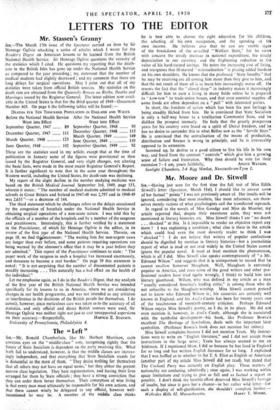LETTERS TO THE EDITOR
Mr. Stassen's Granny
SIR,---The March 17th issue of the Spectator carried an item by Sir Heneage Ogilvie attacking a series of articles which I wrote for the Reader's Digest on American lessons to be learned from the British National Health Service. Sir Heneage Ogilvie questions the veracity of the statistics which I cited. He questions my reporting that the death- rate in the British Isles has gone up under the National Health Service as compared to the year preceding ; my statement that the number of medical students had slightly decreased ; and my comment that there are long delays for surgical operations: May I point out that all of my statistics were taken from official British sources. My statistics on the death rate are obtained from the Quarterly Return on Births, Deaths and Marriages issued by the Registrar General. The latest edition now avail- able in the United Stites is that for the third quarter of 1949—Document Number 403. On page 6 the following tables will be found:—
DEATHS PER TEN THOUSAND POPULATION IN ENGLAND AND WALES These are the statistics used in my article, except that at the time of publication in January some of the figures were provisional as then issued by the Registrar General, and very slight changes, not altering the basic facts, were made in the most recent Registrar General's Report. It is further significant to note that in the same year throughout the Western world, including the United States, the death-rate was declining.
My report of the slight decline in the number studying medicine was based on the British Medical Journal, September 3rd, 1949, page 533, wherein it states: "The number of medical students admitted to medical schools in Great Britain and Ireland in 1947-48 was 2,797 and in 1948-49 was 2,653 "—or a decrease of 144.
The third statement which he challenges refers to the delays occasioned by the congestion of hospitals under the National' Health Service in obtaining surgical operations of a non-acute nature. I was told this by the officials of a number of the hospitals and by a number of the surgeons and practitioners. Interestingly, this is further verified by a -statement in the Practitioner, of which Sir Heneage Ogilvie is the editor, in its review of the firstillyiof the National Health Service. Therein, on page 18, we find t statement: "The waiting lists for non-urgent cases are longer than ever before, and some patients requiring operations are being warned by the almoner's office that it may be a year before they are admitted." This report of the Practitioner continues to state: " The paper work of the surgeon in such a hospital has increased enormously, and threatens to become a real burden." On page 39 this statement is noted: " It is not surprising that the number of discontented patients is steadily increasing. . . . This naturally has a bad effect on the health of the individual."
Let me emphasise again, as I do in the Reader's Digest, that my analysis of the first year of the British National Health Service was intended specifically for its lessons to us in America, where we are considering changes in our health programme, and was not intended as any criticism or interference in the decisions of the British people for themselves. I do submit, however, since meticulous care was taken as to the accuracy of all statistics, and only official and direct British sources were used, Sir Heneage Ogilvie was neither right nor just to cast unsupported aspersions Before the National Health Service Went into Effect After the National Health Service Went into Effect September Quarter, 1947 89 September Quarter, 1948 93 December Quarter, 1947
111
December Quarter,- 1948 115
March Quarter, 1949 149 March Quarter, 1948 .
3
June Quarter, 1949 110 June Quarter, 1948. 102 September Quarter, 1949 92 on their accuracy.—Respectfully, HAROLD E. STASSEN. University of Pennsylvania, Philadelphia 4.










































 Previous page
Previous page